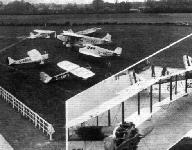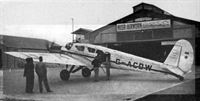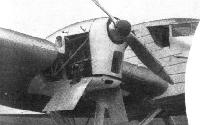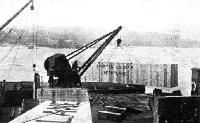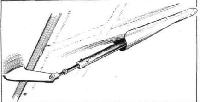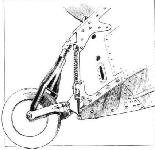
Описание
Страна : Великобритания
Год : 1932
Трехмоторный легкий транспортный самолет
Spartan (Великобритания). Монопланы
<...>
Последней машиной компании стал трехмоторный легкий транспортный самолет Spartan Cruiser. Он был создан на базе построенного в единственном экземпляре самолета Saro-Percival Mailplane, спроектированного Эдгаром Персивалем для компании "Saro". Специалисты "Spartan" получили права на Mailplane и переделали внутреннюю компоновку для экипажа из двух человек и шести пассажиров, присвоив новой машине название Cruiser I. Силовая установка осталась прежние - три двигателя de Havilland Gipsy III мощностью по 120 л. с. Серийный Cruiser II (построены 12 самолетов) имел более мощные двигатели. Кроме того, до прекращения сборки в мае 1935 года были построены еще и три самолета Cruiser III.
ТАКТИКО-ТЕХНИЧЕСКИЕ ХАРАКТЕРИСТИКИ
Spartan Cruiser II
Тип: трехмоторный легкий транспортный самолет
Силовая установка: три рядных ПД de Havilland Gipsy Major, Cirrus Hermes IV или Walter Major 4 no 130 л. с. (97 кВт)
Летные характеристики: максимальная скорость 214 км/ч; практический потолок 4570 м; дальность 499 км
Масса: пустого 1656 кг; максимальная взлетная 2812 кг
Размеры: размах крыла 16,46 м; длина 11,94 м; высота 3,05 м; площадь крыла 40,50 м2
Описание:
- Spartan (Великобритания). Монопланы
- Flight, July 1932
The Spartan "Cruiser” - Flight, November 1932
British Aircraft - Flight, November 1934
MODERN BRITISH AIRCRAFT REVIEWED
Фотографии
-
Flight 1931-07 / Flight
Регистрационный номер: G-ABLI [6] THE SARO PERCIVAL MONOPLANE: The Saro Percival Monoplane is the first 3-engined long-range mail plane to be built in this country, and from the preliminary tests it would appear that it will fulfil this duty in a remarkably efficient manner. The engines are three Gipsy III's and, as can be seen from the photograph, are very neatly cowled in. The landing run is very short indeed, while the landing speed, although figures may not yet be quoted, is also very low. This fact, together with the immunity from forced landings which the three-engine arrangement will give, should make the Saro Percival an ideal night mail carrier; a type which will be found invaluable in many parts of the world.
-
Flight 1932-09 / Flight
Refuelling Capt. N. Stack's Spartan Mailplane from the Shell and "B.P." lorry at Heston prior to his flight to India and back.
-
Aeroplane Monthly 1985-10 / J.Stroud - Wings of Peace
Регистрационный номер: G-ABLI [6] A FIRST PUBLIC APPEARANCE: The Saro-Percival three-engined monoplane (Gipsy III) paid a visit to Heston on Saturday last, piloted by Mr. Percival himself, who had just brought the machine over from Martlesham where it had been undergoing official tests. Ability to fly on any two of the three engines is one of the features of this machine.
The Saro A.24 Mailplane after Spartan Aircraft had fitted twin fins and rudders and installed windows in the mail compartment. -
Aeroplane Monthly 1983-01 / J.Silvester - Percival Aircraft 1933-1954 (1)
Регистрационный номер: G-ABLI [6] The Saro-Percival Mailplane, G-ABLI, designed by Capt E. W. Percival, was built at Cowes in 1931. The design led to the Spartan Cruiser of which 16 were produced. The Mailplane was powered by three 120 h.p. D. H. Gipsy III engines and was a single seat aircraft with a large mail compartment taking up the bulk of the fuselage. Two passenger seats were later added for a flight to India made in June 1932.
-
Air Enthusiast 1994-12 / M.Lowe - Island Hopper
Регистрационный номер: G-ABLI [6] The A 24 shown in its guise as Blackpool, the aircraft used for the record-breaking flight to Karachi in 1932.
-
Air Enthusiast 1994-12 / M.Lowe - Island Hopper
Регистрационный номер: G-ABLI [6] G-ABLI in varied company. Note the single porthole behind the pilot’s cabin - was this prior to the Karachi flight or afterwards? Recognisable among the aircraft in the photograph are Cierva C24 G-ABLM (withdrawn from use December 1934); Puss Moth; Dessoutter (either G-ABFO or G-ABRN); Hendy 302 G-AAVT; Junkers F.13ge G-ABDC (sold in Sweden December 1934) and Comper Swift G-ABPE. Can anyone name and date the occasion?
Другие самолёты на фотографии: Cierva/De Havilland C.24 - Великобритания - 1931Comper Swift / CLA.7 - Великобритания - 1930De Havilland Puss Moth / D.H.80 - Великобритания - 1929Hendy Hendy 302 - Великобритания - 1929Junkers F 13 - Германия - 1919Koolhoven FK-41 - Нидерланды - 1928
-
Flight 1932-05 / Flight
Регистрационный номер: G-ABLI [6] SCENES AT HESTON: Some of the commercial aircraft which were on view - ABGK, Lockheed "Vega"; ABLI, Spartan Mailplane; ABEF, Ford; ABDC, Junkers; ABDH and ABFV, "Puss Moths."
Другие самолёты на фотографии: De Havilland Puss Moth / D.H.80 - Великобритания - 1929Ford Tri-Motor / 4-AT / 5-AT - США - 1926Junkers F 13 - Германия - 1919Lockheed Vega - США - 1927
-
Flight 1932-07 / Flight
Регистрационный номер: G-ABTY [7] THE SPARTAN "CRUISER": "Spats" over the wheels add to the already clean design. The engines are de Havilland "Gipsy III."
-
Aeroplane Monthly 1985-10 / J.Stroud - Wings of Peace
Регистрационный номер: G-ABTY [7] G-ABTY, the first Spartan Cruiser. Passenger entry was via the rear windows on the port side. This window arrangement was not used on the subsequent Cruisers.
-
Flight 1932-07 / Flight
Регистрационный номер: G-ABTY [7] THE LATEST SPARTAN: This new Spartan is a six-seater with three Gipsy III engines. The wing is of plywood, while the roomy fuselage of "Alclad" closely follows the construction of the Saro "Cutty Sark." Flight tests have been made and the machine is very pleasant to handle.
-
Flight 1932-07 / Flight
Регистрационный номер: G-ABTY [7] -
Flight 1933-08 / Flight Advertisements
Регистрационный номер: G-ABTY [7] The Spartan "Cruiser" as seen from below. Its controllability is exemplified by the steep climb, this photograph being taken directly after the take-off. Even at this angle it is obvious that the pilot has an excellent forward and downward view.
-
Air Enthusiast 1994-12 / M.Lowe - Island Hopper
Регистрационный номер: G-ABTY [7] The Cruiser I G-ABTY showing its unusual cockpit!cabin glazing.
-
Flight 1932-09 / Flight
1,000 lb. being loaded into the Spartan "Cruiser" for a full-load demonstration.
-
Flight 1932-09 / Flight
AT CROYDON: The Prince is seen de-planing from the Spartan "Cruiser" - in which he flew from Sunningdale
-
Flight 1932-09 / Flight
The Lord Mayor of London going on board the Spartan "Cruiser" (three "Gipsy III's" at Heston. Col. Strange flew the party, which included Col. Shelmerdine, the Director of Civil Aviation, to Maylands Aerodrome, Romford.
-
Flight 1932-11 / Flight
AT BELGRADE: Mr. Jojkitch; Mr. Ballardie; Mr. Mapplebeck; Capt. Markitchevitch, President of the Military Commission; Col. Strange, and three other members of the Commission. The party on the right includes, facing the camera, Lt. Col. Tomic, Commandant of the Belgrade Aerodrome, who is understood to be the senior pilot to have flown on active service in any Air Force in the world. (Balkan War, 1912, in a Bleriot.)
-
Flight 1932-09 / Flight
AT CROYDON: The Heracles (with the Spartan "Cruiser") just before the start for Denmark.
Другие самолёты на фотографии: Handley Page H.P.42 / H.P.45 - Великобритания - 1930
-
Flight 1933-08 / Flight
Spartan "Cruiser" (3 "Hermes IV") six seater.
-
Aeroplane Monthly 1985-10 / J.Stroud - Wings of Peace
Регистрационный номер: G-ACDW [6] Spartan Air Lines Cruiser II G-ACDW Faithful City about to leave Croydon for the Isle of Wight on May 1, 1934. It has metal propellers and hinged panel entry to the cockpit. The starting handle has been inserted beneath the nose engine.
-
Aeroplane Monthly 1974-10 / P.Moss - British Airways (1)
Регистрационный номер: G-ACDW [6] HOMEWARD BOUND: The Faithful City photographed at Almaza Aerodrome, Cairo, on its way home.
Spartan Air Lines' Spartan Cruiser III G-ACDW, Faithful City, seen at Misr Airworks base in Egypt. -
Air Enthusiast 1994-12 / M.Lowe - Island Hopper
Регистрационный номер: G-ACDW [6] Captain W P Crawford Greene, the MP for Worcester, chartered Spartan Air Lines Cruiser II G-ACDW for a flight from Heston to Australia and back in October 1933. The aircraft, carrying the name Faithful City, is shown at Heston, loading up.
-
Flight 1934-01 / Flight
Регистрационный номер: G-ACDW [6] WINGS OVER MELBOURNE: The Spartan "Cruiser" (three "Gipsy Majors") chartered by Capt. W. P. Crawford Greene, flying over the modern and well-planned Australian City of Melbourne
-
Air Enthusiast 1994-12 / M.Lowe - Island Hopper
Регистрационный номер: G-ACDW [6] THE SPARTAN CRUISER as used on London - Isle of Wight Air Line Service.
Cruiser II G-ACDW, carrying Spartan Air Lines titles on the fin and Spartan’s short-lived logo.
Spartan Airlines' Spartan Cruiser II G-ACDW began operating from Cowes on the Isle of Wight to Heston in 1933. -
Aeroplane Monthly 1985-10 / J.Stroud - Wings of Peace
Регистрационный номер: G-ACDW [6] Spartan Air Lines Cruiser II G-ACDW flying off Cowes, Isle of Wight.
-
Air Enthusiast 1994-12 / M.Lowe - Island Hopper
Регистрационный номер: G-ACDX Spartan Air Lines Cruiser II G-ACDX at Croydon for the start of the Railway Air Services three times a day service from London to the Isle of Wight, May 1, 1934. The routing linked to the rail service from Croydon to Victoria Station in central London.
-
Flight 1933-11 / Flight Advertisements
Регистрационный номер: G-ACJO [2] -
Air Enthusiast 1994-12 / M.Lowe - Island Hopper
Регистрационный номер: G-ACJO [2] Cruiser II G-ACJO prior to delivery to the Yugoslav airline Aeroput in September 1933.
-
Air Enthusiast 1994-12 / M.Lowe - Island Hopper
Регистрационный номер: G-ACSM [4] Cruiser II G-ACSM served in turn Spartan, British Airways, Northern & Scottish and Scottish Airlines before being impressed into RAF service in April 1940.
-
Aeroplane Monthly 1974-10 / P.Moss - British Airways (1)
Регистрационный номер: G-ACSM [4] Spartan Cruiser G-ACSM in British Airways ownership, but late of Spartan Air Lines, when it was named Sussex.
-
Aeroplane Monthly 1985-10 / J.Stroud - Wings of Peace
Регистрационный номер: G-ACSM [4] Northern and Scottish Airways' Cruiser II, G-ACSM, at Glenbrittle, Skye, still carrying British Airways' name beneath the cabin windows.
-
Aeroplane Monthly 1974-10 / P.Moss - British Airways (1)
Регистрационный номер: G-ACVT Spartan Air Lines' Spartan Cruiser II G-ACVT used on the London-Isle of Wight service.
-
Air Enthusiast 1994-12 / M.Lowe - Island Hopper
Регистрационный номер: G-ACYL G-ACYL in the colours of United Airways, to whom it was delivered in October 1934.
United Airways' Spartan Cruiser II G-ACYL on loan from Spartan Air Lines -
Aeroplane Monthly 1985-10 / J.Stroud - Wings of Peace
Регистрационный номер: G-ACZM [3] British Airways' Cruiser II G-ACZM at Newtownards, Northern Ireland.
-
Air Enthusiast 1994-12 / M.Lowe - Island Hopper
Регистрационный номер: G-ACZM [3] The last Mk II G-ACZM at Blackpool’s Stanley Park in the colours of British Airways.
-
Aeroplane Monthly 1974-10 / P.Moss - British Airways (1)
Регистрационный номер: G-ACZM [3] Spartan Cruiser II G-ACZM after transfer to British Airways.
-
Flight 1934-08 / Flight
Регистрационный номер: G-ACOU ANOTHER "CRUISER" FOR BATAS: The Spartan, recently delivered at Zlin by Lt. Col. LA. Strange, has three Walter-Junior-Major engines.
-
Flight 1934-01 / Flight
PILOT AND PASSENGERS: Left to right, Mr. P. W. Lynch-Biosse, Capt. W. P. Crawford Greene and Lord Apsley. The other member of the crew is doing a job of work in the cabin.
-
Air Enthusiast 1994-12 / M.Lowe - Island Hopper
Spartan Air Lines original pilots: left to right R T Halliwell, R H McIntosh, P Lynch Blosse and L W van Oppen.
-
Aeroplane Monthly 1985-10 / J.Stroud - Wings of Peace
Регистрационный номер: YI-AAA [2] Flying at Cowes as YI-AAA. Under this registration it was owned by Iraq Airwork for service between Baghdad and Mosul.
-
Flight 1933-09 / Flight Advertisements
Регистрационный номер: YI-AAA [2] -
Aeroplane Monthly 1985-10 / J.Stroud - Wings of Peace
Регистрационный номер: YU-SAO Aeroput’s Cruiser II YU-SAO. The airline operated two British-built Cruisers and acquired a licence to build further examples in Yugoslavia. It appears that Aeroput built only one, YU-SAP.
-
Air Enthusiast 1994-12 / M.Lowe - Island Hopper
Регистрационный номер: G-ACYK [5] The first Mk III G-ACYK, destined to collide with a hill in Scotland. Note the ‘trouser’ fairings around the undercarriage.
-
Flight 1935-04 / Flight Advertisements
Регистрационный номер: G-ACYK [5] -
Aeroplane Monthly 1985-06 / N.Ewart - When flying was still an adventure (3)
Регистрационный номер: G-ACYK [5] Visiting aircraft at Croydon in the late Thirties.
Другие самолёты на фотографии: Armstrong Whitworth Scimitar / A.W.16 / A.W.35 - Великобритания - 1931Cierva/Avro C.30A / Rota - Великобритания - 1932De Havilland Dragon Rapide / Dominie / D.H.89 - Великобритания - 1934Saunders-Roe Cloud / A.19 - Великобритания - 1930
-
Aeroplane Monthly 1985-10 / J.Stroud - Wings of Peace
Регистрационный номер: G-ACYK [5] Scottish Airways Cruiser III G-ACYK, still bearing the old company name, after its crash near Largs on January 14, 1938. The effect of the crash on metal and wooden propellers is of interest. The accident was caused by a sudden drop in atmospheric pressure while flying in poor visibility.
-
Air Enthusiast 1994-12 / M.Lowe - Island Hopper
Регистрационный номер: G-ACYK [5] Surviving relic. The centre fuselage of Cruiser III G-ACYK is displayed at the Museum of Flight, East Fortune.
-
Aeroplane Monthly 1985-10 / J.Stroud - Wings of Peace
Регистрационный номер: G-ADEL [4], X9432 [4] The second Cruiser III on a test flight. This aircraft was impressed into the RAF as X9432 in April 1940, and was scrapped that June.
-
Мировая Авиация 241
Регистрационный номер: G-ADEL [4], X9432 [4] Spartan Cruiser эксплуатировались преимущественно гражданскими операторами в Великобритании и Австралии. Три машины попали в британские ВВС в начале Второй мировой войны.
-
Air Enthusiast 1994-12 / M.Lowe - Island Hopper
Регистрационный номер: G-ADEL [4], X9432 [4] Mk III G-ADEL in flight over the Isle of Wight.
-
Air Enthusiast 1994-12 / M.Lowe - Island Hopper
Регистрационный номер: G-ADEM Cruiser III G-ADEM in the colours of Railway Air Services.
-
Aeroplane Monthly 1985-10 / J.Stroud - Wings of Peace
Northern and Scottish Airways Cruiser III and Cruiser IIs at Renfrew.
-
Flight 1935-04 / Flight
A NEW VERSION. This new model of the Spartan "Cruiser" (three Gipsy "Majors") has a cantilever undercarriage with "full-cut trousers." The front part of the fuselage is still built-up, boat-fashion, of light alloy, but the rear part is now a welded steel-tube structure with doped fabric covering. The machine, which was one of the exhibits at last Saturday's Egyptian Mission visit to Croydon, is being used by Spartan Air Lines between London and Isle of Wight.
-
Flight 1935-05 / Flight
A section of the long line of machines on exhibition. In the foreground is the B.A.C. "Drone," then a Spartan "Cruiser," a Railway Air Services D.H.86, the K.L.M. Douglas D.C.2, and others.
Другие самолёты на фотографии: De Havilland Express Air Liner / D.H.86 - Великобритания - 1934Douglas DC-1 / DC-2 / C-32 / C-39 - США - 1933Kronfeld Drone - Великобритания - 1932
-
Flight 1933-12 / Flight
EN ROUTE FOR INDIA: A Spartan "Cruiser" being shipped from Southampton for the Maharajah of Patiala.
-
Aeroplane Monthly 1985-10 / J.Stroud - Wings of Peace
Spartan Cruiser with six-passenger layout.
-
Air Enthusiast 1994-12 / M.Lowe - Island Hopper
Регистрационный номер: G-ADEL [4], X9432 [4] Poster for the Spartan Air Lines/Railway Air Services service to!from the Isle of Wight. Mk III G-ADEL is depicted.
-
Aeroplane Monthly 1986-08 / Painted Wings
Theo Fraser's Over the sea to Skye depicts a Spartan Cruiser II in a dramatic setting.
-
Aeroplane Monthly 1985-10 / J.Stroud - Wings of Peace
Регистрационный номер: G-ACSM [4] KEITH WOODCOCK’S painting shows the Spartan Cruiser II G-ACSM in Scottish Airways’ colours.
-
Flight 1933-11 / Flight
This diagram shows the alternative cabin arrangement for the new Spartan "Cruiser."
-
Flight 1932-07 / Flight
On the left one of the wing engine mountings. On the right a wing engine installation.
-
Flight 1932-07 / Flight
The oil tank of each wing engine is mounted in the fairing behind the engine.
-
Flight 1932-07 / Flight
ON THE "CRUISER": The aileron crank and its fairing.
-
Flight 1932-07 / Flight
ON THE "CRUISER": The tail wheel, which is sprung and swivelled, the sideways movement being limited by rubber buffers.
-
Flight 1932-07 / Flight
Spartan Cruiser 3 Gipsy III Engines
- Фотографии






